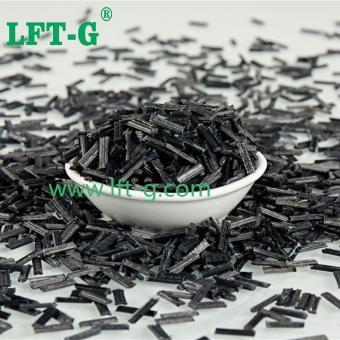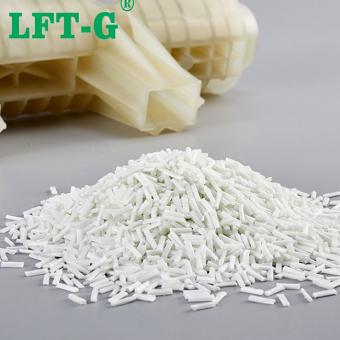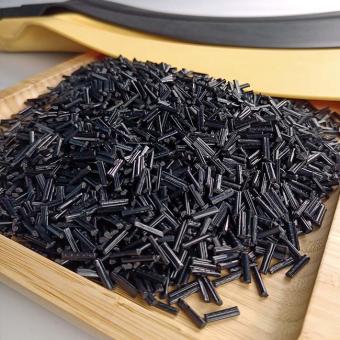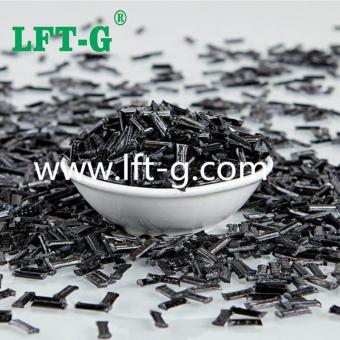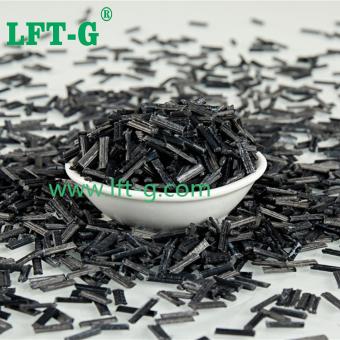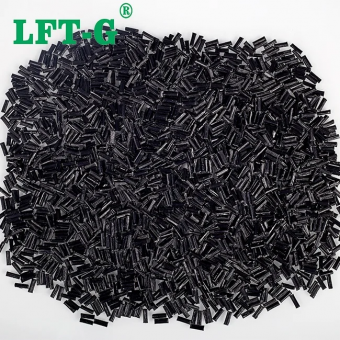-
PLA Long carbon fiber Reinforced polylactic acidPLA materials are current pioneering materials in biodegradable materials. Long carbon fiber Reinforced polylactic acid PLA modified materials are likely to become global advantages in future green materials.
- PLA long carbon fiber
- Reinforced polyactic
- PLA composite
- long carbon fiber with PLA
- PolyacticDegradable material
Tags :
-
LFT-G PLA Polylactic acid composite long glass fiber thermoplastic resin original colorPLA PLA (polylactic acid) is also known as polylactic acid, the production process of polylactic acid is pollution-free, and the product can be biodegradable to achieve recycling in nature, so it is an ideal green polymer material, and one of the representatives of biodegradable plastics. The structure of PLA has important influence on its heat resistance, toughness, mechanical strength, degradability and biocompatibility. The influence on heat resistance is mainly discussed below. There is only one submethylene on the main chain of PLA molecule, the molecular chain has a spiral structure, and its activity is poor. As a result, the PLA after injection molding almost does not crystallize due to slow crystallization speed, so the heat resistance of the product is poor. During hot processing, the ester bond is partially broken to produce terminal carboxyl group, which plays an autocatalytic degradation effect on the thermal degradation of PLA. LGF reinforced PLA The rigidity of the fiber makes it play the role of skeleton support in the polymer matrix. When the polymer is heated, the movement of the chain segment is limited, thus improving the heat resistance of the material. At present, the fibers that can be used for enhancement modification of PLA include natural plant fiber (sisal, flax, linen, bamboo, coconut, wood fiber, etc.), natural animal fiber (silk, etc.), mineral fiber (basalt fiber, etc.), and chemical fiber (carbon fiber, glass fiber, etc.). Among these fibers, carbon fiber and glass fiber are widely used for their high strength and high modulus. Natural plant fiber has been widely studied because of its wide source, degradability and improved thermal and mechanical properties of composites. Modified natural fiber and modified inorganic fiber (glass fiber or carbon fiber) were mixed into the PLA matrix to prepare two kinds of fiber reinforced PLA composites. The test results show that the Vica softening temperature of the composites exceeds 140℃. Compared with Short fiber(SGF) Compared with the short fiber, it has more excellent performance in mechanical properties. It is more suitable for large products and structural parts. It has 1-3 times higher (toughness) than short fiber, and the tensile strength (strength and rigidity) is increased by 0.5-1 times. Injection molding Lab Warehouse Certification Xiamen LFT composite plastic Co., Ltd Xiamen LFT composite plastic Co., Ltd. is a brand-name company that focuses on LFT&LFRT. Long Glass Fiber Series (LGF) & Long Carbon Fiber Series (LCF). The company's thermoplastic LFT can be used for LFT-G injection molding and extrusion, and can also be used for LFT-D molding. It can be produced according to customer requirements: 5~25mm in length. The company's long-fiber continuous infiltration reinforced thermoplastics have passed ISO9001&16949 system certification, and the products have obtained lots of national trademarks and patents.
- PLA composite plastic
- polyactic acid materials
- modified pla compounds
- pla long glass fiber lgf
- long glass fiber filling pla
- lft-g pla lgf
Tags :
-
LFT-G PP Polyphenylene blends long carbon fiber thermoplastic resin original color sample available 12mmPP material Polypropylene fiber has remarkable performance. Compared with other fibers, polypropylene fiber has the lightest, warmest and most hydrophobic fiber properties. The density of polypropylene fiber is only 0.91g/cm3, which is the smallest among the five synthetic fibers and about 34% lighter than polyester fiber; the insulation rate of polypropylene fiber is 36.49%, which is the highest among the five synthetic fibers and 1.7 times that of polyester; the standard moisture regain rate of polypropylene fiber is almost zero, and the hydrophobic and moisture-conducting properties are the best. At the same time, polypropylene fiber has good acid and alkali resistance and heat aging properties. PP-LGF reinofrced material Long carbon fiber reinforced composites can solve your problems when other methods of reinforced plastics do not provide the performance you need or if you want to replace metal with plastic. Long carbon fiber reinforced composites offer significant weight savings and provide optimum strength and stiffness properties in reinforced thermoplastics. The excellent mechanical properties of long carbon fiber reinforced composites make it an ideal replacement for metals. Combined with the design and manufacturing advantages of injection molded thermoplastics, long carbon fiber composites simplify the re-imagining of components and equipment with demanding performance requirements. Its widespread use in aerospace and other advanced industries make it and a "high-tech" perception of consumers - you can use it to market products and create differentiation from competitors. Datasheet of PP-LCF Injection molding Aplication of PP-LCF More suitable for large parts and structural parts. Other application fields you can contact us for technical supports. Test 1. Heat Deflection Temperature Testing 2. Vicat Softening Temperature Testing 3. Tensile Testing 4. Flexural Strength Testing 5. Elongation Testing 6. Density Testing 7. Melt Flow Rate Testing 8. Impact Strength Testing. 9. Etc. Production process 1. The original carbon fiber is physically and chemically treated to remove impurities, improve surface activity, and enhance the mechanical properties and durability of the prepreg. 2. Add resin, curing agent, additives, etc. to form a formula to improve fluidity, hardness, and temperature stability. 3. The pretreated carbon fiber is placed on the machine and compounded with resin. 4. The machine solidifies the words and the two are fully bonded. 5. Cut into 5mm-24mm particles according to the needs of manufactured products。 Certification 1. Quality Management System ISO9001/16949 Certification 2. National Laboratory Accreditation Certificate 3. Modified Plastics Innovation Enterprise 4. Honorary Certificate 5. Heavy metal REACH & ROHS testing Frequently asked questions Q. What are the advantages of long carbon fiber materials? A. Thermoplastic LFT long carbon fiber material has high rigidity, good impact strength, low warpage, low shrinkage, electrical conductivity and electrostatic properties, and its mechanical properties are better than glass fiber series. Long carbon fiber has the characteristics of lighter and more convenient processing to replace metal products. Q. Are there any special process requirements of long carbon fiber injection molding products? A. We must consider the requirements of long carbon fiber for the injection molding machine screw nozzle, mold structure and injection molding process. Long carbon fiber is a relatively high cost material, and need to evaluate the cost performance problem in the selection process. Q. The cost of long fiber products is higher. Does it has a high recycling value? A. The thermoplastic LFT long fiber material can be recycled and reused very well
- Long carbon fiber Reinforced Polypropylene for electrial accessories
- self owing pp pellets
- best long carbon fiber pp lcf30 granules
- PLA Composite Pellets
- Modified Plastic pellets
- pp modified granules manufacturer
Tags :
-
LFT-G brand high performance PLA materials filling long carbon fiber compounds high toughness 12mm lengthPLA materials Polylactic acid (PLA), also known as polypropyleneglycolate, raw materials from corn, potatoes and other starch-containing food crops or crop straw cellulose, by modern biological fermentation technology to produce high-purity small molecules of lactic acid contained in the human body, and then the lactic acid prepared into a cyclic dimer propyleneglycolate, and then the propyleneglycolate ring-opening polymerization to produce polylactic acid and then after a special polymerization reaction The lactic acid is then prepared into a cyclic dimer, which is then ring-opened and polymerized to produce polylactic acid. Because of its reliable biosafety, biodegradability, environmental friendliness, good mechanical properties and easy processing, PLA has a broad application prospect in biomedical polymers, textile industry, plastic industry, furniture industry, agricultural land film and packaging industry, etc. The raw materials of PLA are sufficient and renewable, and the products made from it can be composted directly after use, and eventually can be completely degraded to CO2 and H2O. PLA is an environmentally friendly, green and sustainable polymer material. PLA-LCF materials Long carbon fiber reinforced composites offer significant weight savings and provide optimum strength and stiffness properties in reinforced thermoplastics. The excellent mechanical properties of long carbon fiber reinforced composites make it an ideal replacement for metals. Combined with the design and manufacturing advantages of injection molded thermoplastics, long carbon fiber composites simplify the re-imagining of components and equipment with demanding performance requirements. It's widespread use in aerospace and other advanced industries makes it a "high-tech" perception of consumers. LCF & SCF Long carbon fiber and short carbon fiber mainly refer to the application length of carbon fiber materials, there is no strict fixed distinction between the two, generally between a few millimeters to a few centimeters, the more common specifications are 6mm, 12mm, 20mm, 30mm, 50mm. the shorter the length the easier it is to uniformly and non-directionally distributed in the resin matrix. Therefore, the mechanical properties of short carbon fibers are far less than those of long carbon fiber reinforced thermoplastic composites. LCF & Metal Product processing Details Number Length Color Sample Packge MOQ Port of Loading Delivery time PLA-NA-LCF30 12mm (also can be customized) Natural color (also can be customized) Available 25kg/bag 25kg Xiamen Port 7-15 days after shipment Q & A 1. How does thermoplastic carbon fiber composite material achieve low cost and environmental protection? Thermoplastic carbon fiber composites are used to make parts for high-end machinery. They have excellent machinability, vacuum forming, stamping mold plasticity, and bending processability. For example, Teijin has been able to add a recycling process to the process according to special needs, and to shred and mold the corners of thermoplastic carbon fiber composites after stamping to make recycled materials for making small products or for molding nuts and studs on carbon fiber prototypes. This method can greatly reduce the loss of raw materials, improve the efficiency of the use of thermoplastic carbon fiber composite materials, reduce the overall cost, and thus achieve the purpose of environmental protection. Thermoplastic carbon fiber products production process In addition, compared with thermoset carbon fiber composites, thermoplastic carbon fiber composites can shorten the molding cycle time due to its special process characteristics, which can further reduce the production cost in terms of production efficiency. 2. Is thermoplastic carbon fiber composite material only suitable for injection molding? From the process point of view, injection molding has a higher degree of automation compared with molding, and the raw material is not in contact with the outside world, so the product appearance quality is guaranteed, and there are no black spots, impurities, uneven colors, etc. The mechanical properties, dimensional stability and precision of the product are relatively higher. At present, Japan Toray, these carbon fiber giants in the application of carbon fiber reinforced thermoplastic composites, the main use of injection molding method, and this method is suitable for the production of complex-shaped parts and mass production. It should be noted, however, that thermoplastic carbon fiber composites using injection molding must be reinforced with short-cut or powdered carbon fibers, and this process is not applicable to continuous carbon fiber reinforced thermoplastic composites. Compared to injection molding equipment, compression molding equipment and its mold structure are relatively simple and less expensive to manufacture. The molding equipment can be used for both thermosetting and thermoplastic resins, and in the molding of ...
- PLA plastic resin virgin carbon fiber
- pla modified plastic for car parts
- PLA-LCF polymer pellets
- carbon fiber reinforced plastics granules
- pla engineering materials carbon fiber
Tags :
-
LFT-G high rigidity PLA polylactic acid long carbon fiber reinforced material black color 10-12mm customizedPLA plastic Polylactic acid (PLA) fiber is made from starch raw materials such as corn and wheat, converted into lactic acid by fermentation, and then polymerized to obtain PLA, which is made by solution spinning or melt spinning. It is a fiber that completes the natural cycle and has biodegradability. The fiber does not use petroleum and other chemical materials at all, and its waste can be decomposed into carbon dioxide and water under the action of microorganisms in the soil and seawater, so it will not pollute the earth's environment. Since the initial raw material of this fiber is starch, its regeneration cycle is short, about one to two years, and the carbon dioxide it produces can be reduced in the atmosphere by plant photosynthesis. Long carbon fiber reinofrced PLA Carbon Fiber (CF) is an inorganic fiber containing more than 90% carbon. It is made by cracking carbonization of organic fibers under high temperature environment to form carbon main chain mechanism. As a new generation of reinforcing fibers, carbon fiber has excellent mechanical and chemical properties, including: 1) Light weight. Carbon fiber density and magnesium and beryllium is basically equivalent to less than 1/4 of steel, the use of carbon fiber composites as a structural component material can make the structure quality reduction of 30% -40%. 2) High strength and high modulus. The specific strength of carbon fiber is 5 times higher than that of steel and 4 times higher than that of aluminum alloy; the specific modulus is 1.3-12.3 times higher than that of other structural materials. 3) Small coefficient of expansion. Most of the carbon fiber at room temperature coefficient of thermal expansion is negative, the coefficient of thermal expansion under high temperature conditions is small, it is not easy due to high working temperature and expansion and deformation. 4) Good chemical corrosion resistance. In the acid, alkali environment are very stable performance, can be made into various types of chemical corrosion products. 5)Strong fatigue resistance. Its composite materials by stress fatigue millions of cycle test, strength retention rate is still 60%, while 40% of steel, aluminum for 30%, glass fiber reinforced plastic is only 20% -25%. Carbon fiber composites are the re-enforcement of carbon fiber. Although carbon fiber can be used alone and play a specific function, however, it is ultimately a brittle material, only with the combination of matrix materials to form carbon fiber composites, in order to better play the mechanical properties, to carry more load. Long carbon fiber & Short carbon fiber Long carbon fiber (LGF): 6-25mm/ High performance, high cost Short carbon fiber (SCF): less than 6mm/ Low performance, low cost In the composite material made of fibers is sheared or pulled, the fibers are pulled out from the matrix, such a pulling process is conducive to the absorption of energy provided by the loading, the longer the fibers are within a certain length, the greater the absorption of energy, and the more significant its strength. And in the same volume amount, due to the longer the single fiber, the fewer the number of fiber roots, the less stress concentration generated at the fiber end, the more difficult the destruction of the material. From the results of the feedback of practical applications, the various properties of long carbon fiber reinforced thermoplastic composites are more excellent than those of short fibers. ●Will the use of Xiamen LFT-G materials increase the cost? a. The unit cost of the material is slightly higher than aluminum alloy, but the cost/time of secondary metal processing can be saved, which is relatively advantageous overall. b. The unit cost of the material is slightly higher than that of a homogeneous staple fiber reinforced composite material, but LFRT has high dimensional stability, is not easily deformed, and can be assembled after demolding, which saves cooling/pressure retention time for molding and cost/time for fixing fixtures. Product processing Warehouse & laboratory Main products
- Long carbon fiber Reinforced PLA for electrial accessories
- Injection molded PLA green materials lcf
- PLA Composite Pellets long carbon fiber filled
- PLA modified plastic instead metal
- pla polymers pellets long fiber
- LFT-G pla high mechanical properties
Tags :
-
Xiamen LFT-G PLA Polylactic acid composite long glass fiber filling thermoplastic resin original colorPLA PLA (polylactic acid) is also known as polylactic acid, the production process of polylactic acid is pollution-free, and the product can be biodegradable to achieve recycling in nature, so it is an ideal green polymer material, and one of the representatives of biodegradable plastics. The structure of PLA has important influence on its heat resistance, toughness, mechanical strength, degradability and biocompatibility. The influence on heat resistance is mainly discussed below. There is only one submethylene on the main chain of PLA molecule, the molecular chain has a spiral structure, and its activity is poor. As a result, the PLA after injection molding almost does not crystallize due to slow crystallization speed, so the heat resistance of the product is poor. During hot processing, the ester bond is partially broken to produce terminal carboxyl group, which plays an autocatalytic degradation effect on the thermal degradation of PLA. LGF reinforced PLA The rigidity of the fiber makes it play the role of skeleton support in the polymer matrix. When the polymer is heated, the movement of the chain segment is limited, thus improving the heat resistance of the material. At present, the fibers that can be used for enhancement modification of PLA include natural plant fiber (sisal, flax, linen, bamboo, coconut, wood fiber, etc.), natural animal fiber (silk, etc.), mineral fiber (basalt fiber, etc.), and chemical fiber (carbon fiber, glass fiber, etc.). Among these fibers, carbon fiber and glass fiber are widely used for their high strength and high modulus. Natural plant fiber has been widely studied because of its wide source, degradability and improved thermal and mechanical properties of composites. Modified natural fiber and modified inorganic fiber (glass fiber or carbon fiber) were mixed into the PLA matrix to prepare two kinds of fiber reinforced PLA composites. The test results show that the Vica softening temperature of the composites exceeds 140℃. Compared with Short fiber(SGF) Compared with the short fiber, it has more excellent performance in mechanical properties. It is more suitable for large products and structural parts. It has 1-3 times higher (toughness) than short fiber, and the tensile strength (strength and rigidity) is increased by 0.5-1 times. Injection molding Lab Warehouse Certification Xiamen LFT composite plastic Co., Ltd Xiamen LFT composite plastic Co., Ltd. is a brand-name company that focuses on LFT&LFRT. Long Glass Fiber Series (LGF) & Long Carbon Fiber Series (LCF). The company's thermoplastic LFT can be used for LFT-G injection molding and extrusion, and can also be used for LFT-D molding. It can be produced according to customer requirements: 5~25mm in length. The company's long-fiber continuous infiltration reinforced thermoplastics have passed ISO9001&16949 system certification, and the products have obtained lots of national trademarks and patents.
- PLA composite plastic can be recycled
- polyactic acid materials injection molding
- pla long glass fiber reinforced plastic resin
- long glass fiber filling pla sample available
- lft-g pla lgf low warpage
Tags :
-
LFT-G PLA Polylactic acid composite long glass fiber thermoplastic original colorPLA PLA (polylactic acid) is also known as polylactic acid, the production process of polylactic acid is pollution-free, and the product can be biodegradable to achieve recycling in nature, so it is an ideal green polymer material, and one of the representatives of biodegradable plastics. The structure of PLA has important influence on its heat resistance, toughness, mechanical strength, degradability and biocompatibility. The influence on heat resistance is mainly discussed below. There is only one submethylene on the main chain of PLA molecule, the molecular chain has a spiral structure, and its activity is poor. As a result, the PLA after injection molding almost does not crystallize due to slow crystallization speed, so the heat resistance of the product is poor. During hot processing, the ester bond is partially broken to produce terminal carboxyl group, which plays an autocatalytic degradation effect on the thermal degradation of PLA. LGF reinforced PLA The rigidity of the fiber makes it play the role of skeleton support in the polymer matrix. When the polymer is heated, the movement of the chain segment is limited, thus improving the heat resistance of the material. At present, the fibers that can be used for enhancement modification of PLA include natural plant fiber (sisal, flax, linen, bamboo, coconut, wood fiber, etc.), natural animal fiber (silk, etc.), mineral fiber (basalt fiber, etc.), and chemical fiber (carbon fiber, glass fiber, etc.). Among these fibers, carbon fiber and glass fiber are widely used for their high strength and high modulus. Natural plant fiber has been widely studied because of its wide source, degradability and improved thermal and mechanical properties of composites. Modified natural fiber and modified inorganic fiber (glass fiber or carbon fiber) were mixed into the PLA matrix to prepare two kinds of fiber reinforced PLA composites. The test results show that the Vica softening temperature of the composites exceeds 140℃. Compared with Short fiber(SGF) Compared with the short fiber, it has more excellent performance in mechanical properties. It is more suitable for large products and structural parts. It has 1-3 times higher (toughness) than short fiber, and the tensile strength (strength and rigidity) is increased by 0.5-1 times. Injection molding Lab Warehouse Certification Xiamen LFT composite plastic Co., Ltd Xiamen LFT composite plastic Co., Ltd. is a brand-name company that focuses on LFT&LFRT. Long Glass Fiber Series (LGF) & Long Carbon Fiber Series (LCF). The company's thermoplastic LFT can be used for LFT-G injection molding and extrusion, and can also be used for LFT-D molding. It can be produced according to customer requirements: 5~25mm in length. The company's long-fiber continuous infiltration reinforced thermoplastics have passed ISO9001&16949 system certification, and the products have obtained lots of national trademarks and patents.view more
-
Xiamen LFT-G PP Polyphenylene with long carbon fiber thermoplastic resin original colorPP material Polypropylene fiber has remarkable performance. Compared with other fibers, polypropylene fiber has the lightest, warmest and most hydrophobic fiber properties. The density of polypropylene fiber is only 0.91g/cm3, which is the smallest among the five synthetic fibers and about 34% lighter than polyester fiber; the insulation rate of polypropylene fiber is 36.49%, which is the highest among the five synthetic fibers and 1.7 times that of polyester; the standard moisture regain rate of polypropylene fiber is almost zero, and the hydrophobic and moisture-conducting properties are the best. At the same time, polypropylene fiber has good acid and alkali resistance and heat aging properties. PP-LGF reinofrced material Long carbon fiber reinforced composites can solve your problems when other methods of reinforced plastics do not provide the performance you need or if you want to replace metal with plastic. Long carbon fiber reinforced composites offer significant weight savings and provide optimum strength and stiffness properties in reinforced thermoplastics. The excellent mechanical properties of long carbon fiber reinforced composites make it an ideal replacement for metals. Combined with the design and manufacturing advantages of injection molded thermoplastics, long carbon fiber composites simplify the re-imagining of components and equipment with demanding performance requirements. Its widespread use in aerospace and other advanced industries make it and a "high-tech" perception of consumers - you can use it to market products and create differentiation from competitors. Datasheet of PP-LCF Injection molding Aplication of PP-LCF More suitable for large parts and structural parts. Other application fields you can contact us for technical supports. Test 1. Heat Deflection Temperature Testing 2. Vicat Softening Temperature Testing 3. Tensile Testing 4. Flexural Strength Testing 5. Elongation Testing 6. Density Testing 7. Melt Flow Rate Testing 8. Impact Strength Testing. 9. Etc. Production process 1. The original carbon fiber is physically and chemically treated to remove impurities, improve surface activity, and enhance the mechanical properties and durability of the prepreg. 2. Add resin, curing agent, additives, etc. to form a formula to improve fluidity, hardness, and temperature stability. 3. The pretreated carbon fiber is placed on the machine and compounded with resin. 4. The machine solidifies the words and the two are fully bonded. 5. Cut into 5mm-24mm particles according to the needs of manufactured products。 Certification 1. Quality Management System ISO9001/16949 Certification 2. National Laboratory Accreditation Certificate 3. Modified Plastics Innovation Enterprise 4. Honorary Certificate 5. Heavy metal REACH & ROHS testing Frequently asked questions Q. What are the advantages of long carbon fiber materials? A. Thermoplastic LFT long carbon fiber material has high rigidity, good impact strength, low warpage, low shrinkage, electrical conductivity and electrostatic properties, and its mechanical properties are better than glass fiber series. Long carbon fiber has the characteristics of lighter and more convenient processing to replace metal products. Q. Are there any special process requirements of long carbon fiber injection molding products? A. We must consider the requirements of long carbon fiber for the injection molding machine screw nozzle, mold structure and injection molding process. Long carbon fiber is a relatively high cost material, and need to evaluate the cost performance problem in the selection process. Q. The cost of long fiber products is higher. Does it has a high recycling value? A. The thermoplastic LFT long fiber material can be recycled and reused very well
- self owing pp pellets producer whole sell
- PLA Composite Pellets good price made in China
- Modified Plastic pellets home appliances resin
Tags :
-
Xiamen LFT Polylactic acid compounds filled long glass fiber thermoplastic resinPLA PLA (polylactic acid) is also known as polylactic acid, the production process of polylactic acid is pollution-free, and the product can be biodegradable to achieve recycling in nature, so it is an ideal green polymer material, and one of the representatives of biodegradable plastics. The structure of PLA has important influence on its heat resistance, toughness, mechanical strength, degradability and biocompatibility. The influence on heat resistance is mainly discussed below. There is only one submethylene on the main chain of PLA molecule, the molecular chain has a spiral structure, and its activity is poor. As a result, the PLA after injection molding almost does not crystallize due to slow crystallization speed, so the heat resistance of the product is poor. During hot processing, the ester bond is partially broken to produce terminal carboxyl group, which plays an autocatalytic degradation effect on the thermal degradation of PLA. LGF reinforced PLA The rigidity of the fiber makes it play the role of skeleton support in the polymer matrix. When the polymer is heated, the movement of the chain segment is limited, thus improving the heat resistance of the material. At present, the fibers that can be used for enhancement modification of PLA include natural plant fiber (sisal, flax, linen, bamboo, coconut, wood fiber, etc.), natural animal fiber (silk, etc.), mineral fiber (basalt fiber, etc.), and chemical fiber (carbon fiber, glass fiber, etc.). Among these fibers, carbon fiber and glass fiber are widely used for their high strength and high modulus. Natural plant fiber has been widely studied because of its wide source, degradability and improved thermal and mechanical properties of composites. Modified natural fiber and modified inorganic fiber (glass fiber or carbon fiber) were mixed into the PLA matrix to prepare two kinds of fiber reinforced PLA composites. The test results show that the Vica softening temperature of the composites exceeds 140℃. Compared with Short fiber(SGF) Compared with the short fiber, it has more excellent performance in mechanical properties. It is more suitable for large products and structural parts. It has 1-3 times higher (toughness) than short fiber, and the tensile strength (strength and rigidity) is increased by 0.5-1 times. Injection molding Lab Warehouse Certification Xiamen LFT composite plastic Co., Ltd Xiamen LFT composite plastic Co., Ltd. is a brand-name company that focuses on LFT&LFRT. Long Glass Fiber Series (LGF) & Long Carbon Fiber Series (LCF). The company's thermoplastic LFT can be used for LFT-G injection molding and extrusion, and can also be used for LFT-D molding. It can be produced according to customer requirements: 5~25mm in length. The company's long-fiber continuous infiltration reinforced thermoplastics have passed ISO9001&16949 system certification, and the products have obtained lots of national trademarks and patents.
- PLA composite plastic instead metal and steel
- polyactic acid materials High quality and strength
- pla long glass fiber lgf made in China
- long glass fiber filling pla long fiber glass
- lft-g pla lgf thermoplastic resin virgin
Tags :
-
Xiamen LFT PLA filling Long carbon fiber Reinforced polylactic acidPLA materials are current pioneering materials in biodegradable materials. Long carbon fiber Reinforced polylactic acid PLA modified materials are likely to become global advantages in future green materials.
- PLA long carbon fiber high rigidity and strength
- Reinforced polyactic pla instead metal
- PLA composite green materials
- long carbon fiber with PLA modification
Tags :
-
Xiamen LFT PLA filling Long carbon fiber Reinforced polylactic acidPLA materials are current pioneering materials in biodegradable materials. Long carbon fiber Reinforced polylactic acid PLA modified materials are likely to become global advantages in future green materials.view more
-
LFT Polylactic Acid PLA with filler Long Glass Fiber reinforcementPLA is often regarded as being biodegradable.
- Long Glass Fiber Reinforced PLA Properties
- PLA with Long Glass Fiber Strength and Durability
- Long Glass Fiber PLA Composites Applications
- High Performance Long Glass Fiber PLA Materials
- Long Glass Fiber PLA vs. Short Fiber PLA
- Long Glass Fiber PLA Manufacturing Process
Tags :

 e-mail
e-mail English
English français
français Deutsch
Deutsch русский
русский italiano
italiano español
español português
português العربية
العربية 日本語
日本語 한국의
한국의 中文
中文












